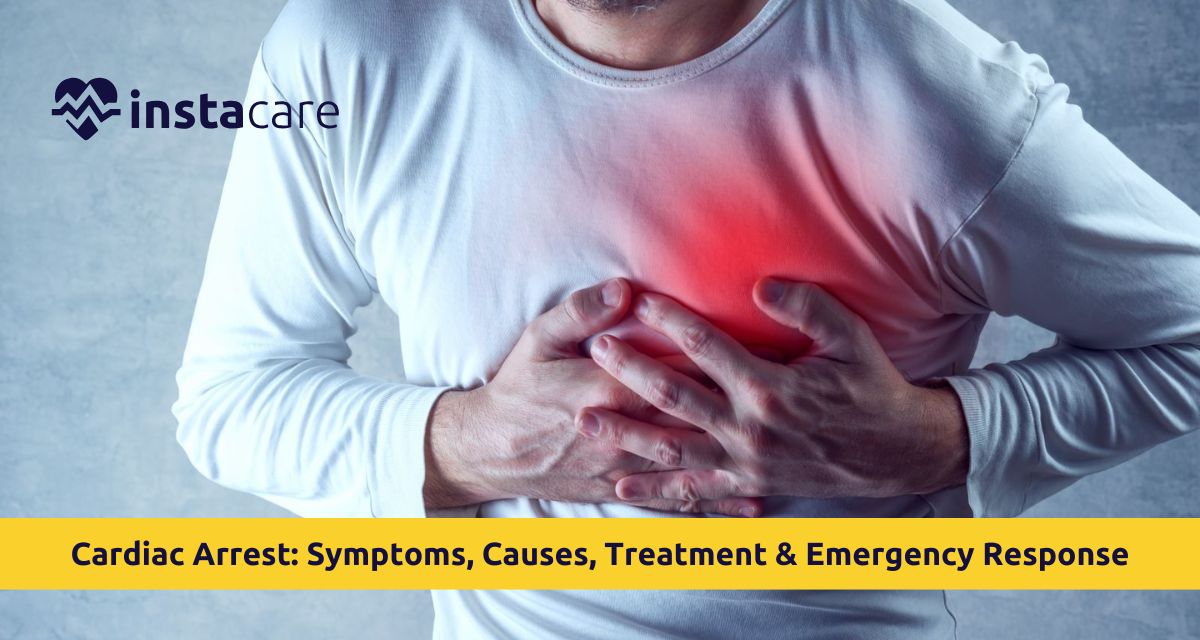Cardiac arrest is a sudden life-threatening condition where the heart simply ceases to beat and thus suspends the flow of blood to the brain and other organs. Cardiac arrest, if not treated, kills an individual within a few minutes through CPR or defibrillation. Cardiac arrest vs heart attack are not same though the two are used synonymously. Identification of warning signs of cardiac arrest, cardiac arrest emergency response, and preventive measures can become extremely useful with improved results.
This article is discussing about what is cardiac arrest, why does it occur, symptoms are, how do they treat it, and how you too can act fast to save your life if you ever have such an issue.
What is Cardiac Arrest?
Abrupt stoppage of the functioning of the heart, typically because of electrical disturbance, making the heart incapable of circulating blood. Contrary to heart attack, a state where a section of the heart lacks blood supply, cardiac arrest results in an absolute failure of the heart.
Sudden cardiac arrest may occur at any moment in most cases and is aimed at patients with or without medico-historical histories of cardiological disorders. The disease is always fatal in case of no treatment but, after proper and timely treatment by CPR and defibrillator therapy, the mortality rate of the victims doubles or triples.
Symptoms of Cardiac Arrest
The cardiac arrest symptoms usually begin unexpectedly and abruptly. The victim will collapse and lose consciousness instantly.
Main warning signs of cardiac arrest are:
- Sudden falling to the floor with no pulse
- No gasping or other unusual breathing
- Falling unconscious
- Chest pain, shortness of breath, or dizziness on the brink of collapse
- Seizure-like movement (seldom falsely misdiagnosed)
It just so happens otherwise in other circumstances, and indeed most particularly in the case of cardiac arrest in sleep, that the individual will never again awaken. It is because of symptoms which might give notice, for instance, warning palpitation of the heart, weakness, or fainting attacks, particularly in individuals who have a susceptibility, may well be worthy of warning.
Causes of Cardiac Arrest
Causes of cardiac arrest have numerous reasons, but each and every one of them has heart disease as a cause along with non-cardiac causes.
Some of the causes are:
- Coronary artery disease
- Heart attack (will result in arrhythmias that cause arrest)
- Arrhythmias like ventricular fibrillation
- Cardiomyopathy (heart muscle disease)
- Congenital heart defect, particularly for cardiac arrest in young adults and adolescents
- Acute electrolyte imbalance, for example, low magnesium or potassium
- Drug overdose or poisoning
- Severe trauma or hemorrhage
- Electric shock
Sudden cardiac arrest in youth occurs due to sudden, unanticipated causes like hypertrophic cardiomyopathy or long QT syndrome. Overexerted patients with normal health are also a causative factor.
Emergency Action for Cardiac Arrest
Early, standardized emergency action for cardiac arrest is the most important factor for cardiac arrest survival rate. Delayed cardiac arrest treatment decreases survival after cardiac arrest by 7%–10% per minute.
The first is:
- Call emergency services: Call emergency services immediately.
- Check responsiveness: Shake the victim and see if he/she is okay.
- Start CPR for cardiac arrest: Press the center of the chest firmly and rapidly with 100–120 compressions per minute., Do not stop until relieved by someone else or a defibrillator is available.
- Apply a defibrillator use in cardiac arrest (AED), if available: Listen and obey the voice/visual instructions, Shock, if instructed by the machine to do so.
- Continue CPR until emergency medical help arrives.
Automatic external defibrillators (AEDs) are placed in public spaces like shopping centers, airports, and schools. It is easy now for everybody to learn how to operate one and rescue a person who is in cardiac arrest.
Medical Treatment of Cardiac Arrest
When paramedical staff reach the scene or patient is admitted in hospital, the treatment that is employed for restoration of normal cardiac rhythm and prevention of deterioration of arrest is:
Certain treatments given in a hospital are:
- Advanced life support: Oxygenation, drug such as epinephrine, and advanced management of airways.
- Defibrillation: Application of automatic defibrillator for restoration of normal rhythm.
- Cardiac catheterization: For heart attack, this will de clot clotted arteries.
- Therapeutic hypothermia: Cooling to preserve brain function.
- Implantable cardioverter-defibrillator (ICD): In patients with high-risk recirculating cardiac arrest.
- Post-cardiac arrest care: ICU monitoring, checking of brain function, and rehabilitation based on the patient.
We don't want to resuscitate the heart but also save the brain and organs and resuscitate them completely.
Prevention of Cardiac Arrest
Although some of the risk factors cannot be reversed, cardiac arrest prevention is done in most cases by early detection, lifestyle change, and prompt intervention.
Key strategies for cardiac arrest prevention:
- Manage heart conditions: Control high blood pressure, cholesterol, and diabetes.
- Avoid smoking and excessive alcohol.
- Low-fat protein diet with fruit- and vegetable-based diet.
- Regular follow up: Especially if personal or family history of sudden death or coronary heart disease.
- Medication adherence: Adhere to medication as directed.
- Access emergency services immediately upon experiencing chest pain, fainting, or sudden shortness of breath.
- In high-risk patients and survivors of cardiac arrest, an ICD can be implanted to pace and defibrillate abnormal rhythms before the arrest.
Public health settings of public defibrillator placement and public education on CPR significantly enhance the ability of the community to act quickly.
Conclusion
Cardiac arrest is an acute and sudden medical emergency. Unlike heart attack, which interrupts flow, cardiac arrest incapacitates the heart, preventing brain and other organ oxygenation. Time is critical, CPR and defibrillator delivery within a few minutes is life or death.
Identification of cardiac arrest symptoms, gaining the skill of acting in an instant, and prevention are a matter of life and death. It is a matter of sheer urgency to provide the victims with their second lease on life both during emergency management and post-cardiac arrest care management in the public domain, workplace, or even home environment.
Please book an appointment with the
Best Cardiologist in Lahore, Karachi, Islamabad, and all major cities of Pakistan through
InstaCare, or call our helpline at 03171777509 to find a verified doctor for your disease.

